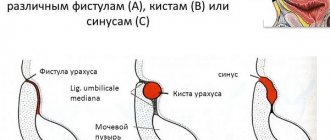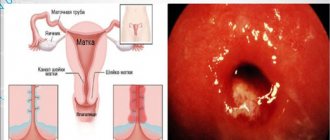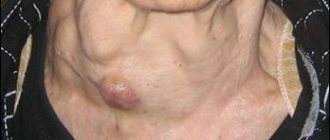Types of pathology
The disease “kidney cyst” refers to urological diseases, and is a hollow “sac” of different sizes. Inside the formation there is a clear protein liquid, in some cases with inclusions of pus and blood.
The tumor lesion is detected, in most cases, only in one of the two kidneys. It is extremely rare that simultaneous cystic lesions of both organs are diagnosed.
Based on quantitative characteristics, education is divided into 2 main groups:
- single;
- multiple (microscopic formations stick together, forming a complex multicapsule structure).
Based on structural features, neoplasms are usually divided into 2 groups:
- simple cyst in the kidney. It is a single vesicle, characterized by the presence of a capsule filled with liquid, without purulent and bloody inclusions;
- complex or multi-chamber kidney cyst (a group of vesicles stuck together but isolated from each other).
The following types of neoplasms are also distinguished:
- Multilocular renal cyst. It is a subspecies of complex formations. Characterized by the presence of many small liquid-filled cavities connected together, bordering each other;
- A cortical kidney cyst is a pathological neoplasm in the cortical layer of the organ. Its appearance is associated with the presence of blockages in the tubules, which provoke retention of liquid contents in this area, push through the epithelium and form a cavity;
- The formation of hollow formations may be associated with the entry of parasites into the human body. Echinococcal kidney cysts are spherical cavities with serous fluid, inside which live larvae of the Echinococcus parasite are contained.
Infection with the parasite occurs through direct close interaction with a sick animal. Echinococcus eggs occupy the human intestines; larvae hatch from the eggs, which are carried through the bloodstream to different organs, fixed in the tissues, where a parasitic formation then appears.
- A kidney retention cyst is a serious complication that occurs as a result of severe infection of organs (tuberculosis, pyelonephritis, urolithiasis, acute or chronic renal failure). It gradually increases in size, which provokes compression of the organ and the appearance of serious disturbances in its functioning.
- An extrarenal kidney cyst is a vesicle filled with serous fluid on the surface of the organ.
What it is?
A kidney cyst is a benign neoplasm, which is a spherical cavity filled with liquid contents. This disease occurs quite often in the practice of urologists and nephrologists.
According to statistics, approximately 25% of adults over the age of 45 have cystic changes of varying severity. Men get sick several times more often than women.
In children, kidney cysts are usually congenital.
Cause of kidney cyst
Thanks to scientific and technological progress in the field of medical diagnostics and the results of scientific research regarding the pathology of the urinary system, experts have identified a list of destabilizing factors that influence the appearance of tumors.
The reasons for the appearance of cysts in the kidneys are explained by the occurrence of a malfunction in the functioning of the tubules responsible for the separation of urine. Stagnation of urine in the tubules puts pressure on the connective tissue of the vessels and affects the appearance of certain depressions, in which, after some time, “bags” with contents form.
The following are the causes of kidney cysts:
- due to harsh external physical or mechanical impact in the lower back area;
- in the form of complications due to previous inflammatory and infectious diseases of the urinary system;
- intrauterine pathologies of organ formation in the fetus;
- hereditary predisposition;
- biological aging of the body;
- the presence of chronic diseases in a person;
- disturbances in the hormonal system.
Forecast for life
The prognosis of a kidney cyst depends on the nature of the neoplasm, its size and location. In most cases, relatively small single-chamber cystic vesicles with slow growth are detected. Their presence is practically asymptomatic and is characterized by favorable prospects. Treatment of such forms of pathology is not required; only periodic examination by a nephrologist is necessary for timely detection of possible complications.
What is an ovarian cyst: symptoms and treatment in women Cyst on the root of a tooth: photos, symptoms and treatment Pyelonephritis - symptoms, diagnosis and treatment Pancreatitis: symptoms, treatment and diet for pancreatitis
Symptoms of a cyst in the kidneys
The process of the appearance of formations, as a rule, goes completely unnoticed and persists until more obvious signs of the presence of somatic ailment appear. The neoplasm may be frozen, that is, remain in its original form. But more often than not, formations in this area tend to increase in size. It is believed that the typical size of neoplasms varies from 3 to 10 cm.
Signs of the presence of a kidney cyst may be indicated by a state of asthenicity, pain in the abdomen and lower back, the onset of fever, and the occurrence of hydronephrosis.
Knowledge of the characteristic signs of the disease helps a specialist to predict the development of cyst formation. Symptoms of a kidney cyst are characterized by the following manifestations:
- increased sensitivity and discomfort when touching or feeling the lumbar region;
- blood pressure surges;
- “meaty” or “purulent” color of urine;
- the occurrence of painful and unpleasant sensations during the process of urination (burning, unexpressed pain, difficulty urinating);
- low level of hemoglobin in the blood;
- tingling in the lumbar region both during rest, while lying down, and during movement.
Development mechanism
The development of a “true”, most common kidney cyst occurs as a result of damage to the nephron tubules. An inflammatory or sclerotic process, trauma to the organ leads to the isolation of a fragment of the tubule from the rest of the initial sections of the urinary tract. Under certain conditions, there is not sclerosis of an isolated area, but a rapid growth of the tubular epithelium, as a result of which a small (about 1-3 millimeters) vesicle is formed. It is filled with a liquid similar in composition to primary urine or filtered blood plasma.
With further division of connective and epithelial tissue cells, a cyst grows, sometimes reaching a size of 10-15 centimeters. Its growth is accompanied by compression of surrounding structures, sometimes this stimulates the development of secondary cystic growths. If the cyst is large, the outflow of urine becomes difficult, the blood vessels supplying the kidney are compressed, and the nerve bundles are irritated. This causes a number of local and general symptoms - pain, fluctuations in blood pressure, intoxication of the body. Sometimes malignancy of the epithelial cells of the neoplasm walls is observed.
Why is a kidney cyst dangerous?
The cyst itself may already be a complication due to a severe infection. It may also contribute to other adverse health effects and may be fatal.
The danger of a kidney cyst is that it, like a living substance, can become infected, fill with pus and break through the walls of the capsule shell, pouring its contents into the organ or tissues. The infection spreads quite quickly, and when pus enters the abdominal cavity, inflammation of the serous covering of the abdominal cavity develops. This condition is interpreted as extremely dangerous to human life and health and requires surgical intervention.
The degree of possible negative consequences, the risk of complications depending on the type, size, structure of neoplasms is revealed in detail during an ultrasound scan of a kidney cyst. The procedure allows you to accurately assess the level of danger of the formation and determine the method of treatment.
Classification according to Bosniak
The Bosniak classification of cysts has been used since 1986. She divides kidney cysts into categories, depending on their ability to degenerate into oncology:
- I – simple, uncomplicated cysts that can be seen using any modern diagnostic equipment. This is the most common degree of development of formations, occurs without symptoms and involves the use of wait-and-see tactics in treatment. The probability of malignancy is 2%.
- This type of kidney cyst has minimal complications. Partitions and calcium deposits in the walls or membranes may already appear in them. The size of the formation does not exceed 3 cm. It does not provide specific treatment; dynamic observation with ultrasound is sufficient. The probability of malignancy is 18%.
- 2FB - in cysts of this category a large number of membranes appear, which, together with the walls, become very thick and contain calcified deposits in the form of nodes. Since such formations contain a minimal amount of tissue elements, contrast does not accumulate in them during ultrasound. The size of the neoplasm can be more than 30 mm; it requires dynamic observation.
- Category III is one of the variants of renal cell oncology. During ultrasound, you can see unclear outlines of the tumor, thickened membranes and heterogeneous calcified areas. It becomes malignant in the presence of provoking factors, such as kidney injuries or exposure to an infectious agent. Treatment involves removal.
- In category 4 tumors, the liquid component predominates; their outlines on the ultrasound machine are uneven and lumpy. They can accumulate contrast in some areas due to the presence of a tissue component, and this is one of the signs of malignant processes. Treatment is exclusively surgery. The probability of malignancy is 92%.
Diagnostics
Detection of neoplasms occurs during an in-depth medical examination. The most well-known and accessible way to carry out a medical examination at the initial stage is a consultation with a specialist (nephrologist, urologist) with a detailed history taking during a conversation with the patient.
Based on the results of the initial examination of the patient, the doctor prescribes urine and blood tests, and the patient monitors his blood pressure readings during the established period of observation. In the process of making a medical diagnosis, a specialist examines the results of laboratory tests of the patient’s biomaterial. Particular attention is paid to quantitative indicators of such key substances as leukocytes, glucose, creatinine, the presence of protein, urea.
One of the ways to assess the state of organ functions and determine its possible pathology is ultrasound. Ultrasound of neoplasms allows you to accurately identify neoplasms, measure them, determine the type of pathology, give a detailed description, including their location, and establish the stage of the disease.
If the ultrasound machine has a Doppler function, it can be used to perform Doppler ultrasound, that is, check the blood vessels for possible anomalies. An alternative to Dopplerography is ultrasonography, that is, ultrasound diagnostics to identify pathological formations and suspicious processes in organs.
Based on the results of the ultrasound, the attending physician selects an individual treatment plan for each patient. Ultrasound examination is a safe diagnostic method for different groups of patients (including pregnant women), and is used to monitor the treatment process of renal diseases.
In order to clarify the diagnosis, the doctor may prescribe additional hardware tests. Actively used hardware diagnostic methods include:
- blood chemistry;
- angiography;
- computed tomography (allows you to see even a small cyst);
- MRI (will make it possible to study the cyst from all sides and determine its size);
- To understand whether a tumor is malignant or benign, the patient is sent to do a radioisotope study.
How to diagnose
Using modern technology, congenital kidney cysts are detected as early as the fifteenth week of embryo development in the mother’s womb. This is done using an ultrasound machine, which shows the number of capsules, their location, size and allows you to assess what disturbances occur in the functioning of the affected kidney. Immediately after the birth of the child, he undergoes a second ultrasound to clarify the diagnosis, and then it is repeated another month later. Only a qualified specialist can detect cystosis at such an early stage.
Ultrasound examination is the main diagnostic procedure for secondary cystosis. Additionally, MRI and CT may be prescribed. CT allows you to see the presence of stones and calcified areas, and MRI determines the extent of the process. If polycystic disease is detected, MR angiography of the head is additionally prescribed to detect protrusion of the walls of blood vessels in the brain. Since kidney problems are often accompanied by pathologies in other organs, an additional ultrasound of the liver and bile ducts may be prescribed, the enlargement of which can be determined using magnetic resonance cholangiography.
Treatment of cysts in the kidneys
The choice of treatment method for a kidney cyst depends on its size, location, degree of damage, manifestations, and impact on the functioning of the affected organ.
In a number of cases, when a dysfunction of the organ is not detected, and the general health of the patient is absolutely normal, specialists simply monitor the patient’s condition. The patient regularly undergoes all necessary tests and undergoes examination.
If the disease begins to progress, then as a treatment for the cyst of the left kidney (the disease of which is more common), as well as the right organ, puncture is performed. During the procedure, fluid is removed from the tumor through a skin puncture.
In some cases, such a procedure cannot be carried out, so surgical intervention is used, during which the tumor is removed along with its capsule. In situations where the disease is caused by infection or inflammation, the following methods are used to treat a cyst of the right kidney, as well as the left organ:
- the patient is undergoing treatment with antibiotics or sulfonamide drugs;
- an individual diet is prescribed;
- all sorts of complications are eliminated.
These methods eliminate the root cause of the pathological process and correct the functioning of internal organs.
Treatment of kidney cysts with medications
In cases where no damage, purulent contents, or malignancy of the neoplasm are observed, drug treatment of the kidney cyst is prescribed. Medicines relieve symptoms and will also help to avoid complications, stop the inflammatory process and relieve pain in the lumbar region.
There is a certain group of drugs for effectively getting rid of formations in this area:
- ACE inhibitors (prevent kidney and heart failure);
- diuretics (diuretics that help normalize the flow of urine);
- painkillers (create an anesthetic effect);
- antibiotics (help relieve inflammation of the organ).
Surgery
In cases where medication does not give a positive result, specialists resort to removing the kidney cyst. This operation takes place in a situation where the tumor interferes with the normal functioning of the organ and has a negative effect on nearby organs and tissues.
Removal of a renal tumor is indicated in the following cases:
- pronounced pain syndrome;
- suppuration of the tumor;
- the diameter of the formation is more than 45 mm;
- very high blood pressure;
- an overgrown tumor seriously impairs the functioning of the affected organ.
Complete removal of the kidney due to a cyst is carried out in cases of a particularly large size of the neoplasm or the cavity with fluid is localized deep in the tissues of the organ.
Surgery is not recommended if the patient has the following diseases and pathological conditions:
- diabetes;
- pathologies of the respiratory or cardiovascular system;
- inflammatory process in the acute stage;
- presence of an allergic reaction;
- absence of pronounced manifestations.
Traditional medicine and kidney cyst
In some cases, the use of folk recipes to combat renal tumors is effectively used as an auxiliary therapy. Before using traditional medicine to get rid of cysts, you should definitely consult a doctor. Herbal medicine may not only be ineffective, but also cause great harm not only to the affected organ, but to the entire body as a whole.
Among the most famous phytotherapeutic methods of combating neoplasms are:
- treatment of kidney cyst with a golden mustache. The plant seeds are infused in vodka for 10 days in a ratio of 50 pcs. for 500 ml. Then the resulting alcohol tincture is taken twice a day after meals. Dosage regimen: first day - 10 drops per 30 ml of water, day 2 a drop more and each subsequent day you need to add 1 drop.
Ultimately, on day 25, you get 35 drops of tincture per 30 ml of water. After this, it is necessary to reduce the dosage in the reverse order. Then take a 7-day break;
- use of Kalanchoe. You need to take fresh leaves of the plant, chew 2 times a day before meals;
- treatment of kidney cysts with celandine. It is necessary to prepare a decoction of the plant. The decoction is prepared very weak - one teaspoon per 1 liter of water. You should not drink more than 200 ml of this decoction, since celandine is a very toxic plant. In order not to harm your own body, but at the same time get maximum benefit, it is recommended to take about 200 ml of milk daily;
- use of burdock. Freshly cut leaves of this plant must be thoroughly washed and chopped in a blender. Squeeze the juice from the resulting pulp and strain. The juice of the fresh plant should be taken three times a day, 1-2 tablespoons, for two months;
- consumption of aspen bark. It needs to be crushed into powder and taken three times a day for about two weeks, half a tablespoon. It is important to drink plenty of liquid;
- green tea with honey. The combination of antioxidant, anti-inflammatory, and antitumor properties of natural products makes drinking green tea with honey an effective remedy for combating tumors. Add 1-2 tsp of honey to the brewed tea;
- drinking viburnum juice. It is necessary to squeeze the juice from fresh viburnum berries, mix with honey in a ratio of 200 ml to 1.5 tablespoons. The product is taken a quarter glass once a day.
Diet therapy
One of the most important components of successful treatment of cystic formations is a specially designed dietary table. A certain diet will help get rid of a cyst in the kidney:
- it is necessary to completely avoid fried, smoked, fatty foods;
- you need to minimize the amount of salt consumed or completely stop using it;
- absolute rejection of bad habits (drinking alcoholic beverages, smoking);
- in case of cystic formation in the kidney, it is optimal to preferentially consume steamed and stewed dishes with minimal addition of vegetable oils;
- A big plus in the fight against tumors will be minimal consumption of black tea and coffee. Ideally, it is recommended to eliminate coffee completely;
- It is important to maintain the correct drinking regime: you need to consume at least 1.5 liters. water per day. It is recommended to drink water no earlier than 1.5 hours after eating.
Types of renal cysts
- A simple or solitary cyst in the form of a single cavity. A solitary cyst does not pose a great danger due to the fact that it gives only minor complications and does not have the risk of degeneration into kidney cancer.
- A complex cyst is a formation with several cavities on one kidney. With a complex cyst, a change occurs in the wall, thickening of the septa. Complex cysts have the properties of “calcification”; calcium minerals are deposited in the cavities of the cyst, which can be either thin or thick. Complex cysts have a low risk of developing kidney cancer.
Complications and prognosis for kidney cysts
Complications of a kidney cyst may occur if medical care is not provided in a timely manner. Pathology can manifest itself with the following consequences and complications:
- chronic renal failure;
- hydronephrosis (hydrosis of organs);
- purulent pyelonephritis;
- peritonitis due to cyst rupture;
- suppuration of the liquid contents of the neoplasm;
- high blood pressure;
- the appearance of stones in this area;
- high risk of tumor rupture, which can be triggered by even a minor injury in the lumbar region.
The prognosis for a kidney cyst depends on a number of factors, for example, the size of the cyst, its nature and location. Single-chamber cysts of small size and slow growth have fairly favorable prospects. The presence of such a neoplasm does not have pronounced symptoms and does not have a significant impact on the patient’s quality of life.
The prognosis for neoplasms in this area may worsen as a result of relapses or genetic pathologies, although such cases are extremely rare.
An unfavorable prognosis is observed in cases of the development of neoplasms on both organs due to congenital anomalies. The prognosis for multiple congenital formations is especially serious; this type of cyst is not compatible with life.
The feasibility of prevention
Congenital renal cysts cannot be prevented. With inherited PLD, you can only slow down the decline in organ function. The earlier the disease is detected, the greater the chances of a complete recovery.
A doctor can determine kidney failure using simple laboratory tests. The situation is very different from acquired polycystic kidney disease. They should be prevented using general preventive measures - normalization of blood pressure and blood lipids. It is also recommended to undergo regular preventive examinations.










